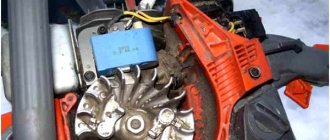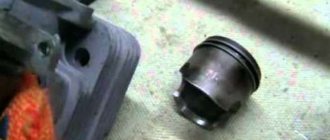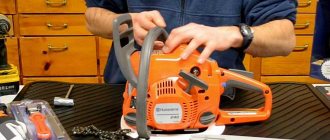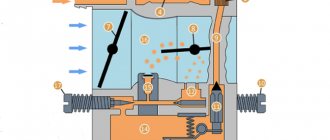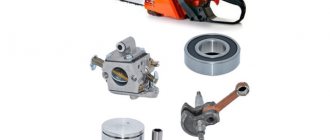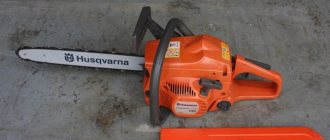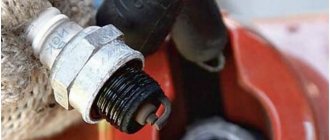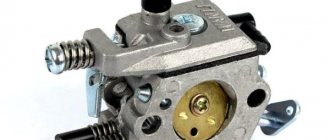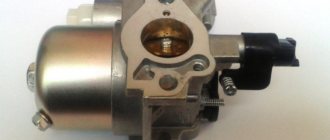Chainsaw CARVER starting problems and repairs
Chainsaw CARVER PROMO PSG 45-15 1st serious test and 1st breakdown Find out how to test yourself.
Carburetor design on a Carver chainsaw
Most modern chainsaws (Carver is no exception) have either completely identical carburetors from the first manufacturer (for example, Walbro), or are very similar in design. But even with the difference in the external appearance of the body, the operating mechanism of all carburetors is completely uniform.
But the carburetors on Carver saws differ from other chainsaws in the availability of regulation. The adjustment screws on most other pollen models are hidden under the body and often have uniquely shaped recesses. Therefore, they can only be adjusted with special branded screwdrivers, which are sold in service centers. The Carver carburetor is adjusted with an ordinary flat-head screwdriver. The case has three holes for screw adjustment. Therefore, the carburetor on a Carver chainsaw can be adjusted without even removing the cover.
Operating principle of a Carver carburetor
After starting the chainsaw motor, the air damper opens, through which purified air enters a diffuser with a small filter. Gasoline gets there through calibrated holes in the jets. The amount of air-fuel mixture that enters the combustion chamber from the carburetor is regulated by the position of the throttle valve, connected by a rod to the throttle handle.
The needle valve cuts off the flow of gasoline to the carburetor when it is full. Gasoline passes through a filter before entering the injectors, reducing the risk of clogging the calibrated holes in them.
STIHL saws and Partner
In chainsaws STIHL 250, 361, also Partner 351, 350, the carburetor is adjusted using screws H and L by setting the proportions of gasoline and air. If you release them, then a large part of the fuel will be added and therefore the speed will be high, otherwise, on the contrary, it will drop.
Idle speed in Partner chainsaws is regulated using a screw with the letter T, and in Shtil, it is usually necessary to find the aircraft marking. Standard adjustment of the chainsaw is carried out during finishing tests. Basically, after such options, the percentage of fuel in the working mixture is greater than air, which does not correspond to good characteristics. But they need to be saved during the first hours of operation during the running-in of the device. After which the saw can be adjusted independently, but it will work perfectly even on industrial settings.
But if it is decided to regulate without the help of others, then the actions must be performed in the following sequence:
- adjusting screw L;
- later adjust the jet H;
- then proceed to adjusting the idle speed using screw T (if chainsaw is LA).
At first, screw L must be turned in both directions in order to find the highest engine speed. If that point is found, then turn the same screw by ¼, slowing down the speed a little. If, despite all this, the chain continues to move at idle, you must immediately turn screw T (LA) until the chain stops completely.
After selecting the highest speed with screw H, you need to check the frequency on the tachometer. In this case, when it does not correspond to those indicated in the service book, the setting must be repeated. When at high speeds a lot of smoke comes out of the exhaust pipe, then the mixture is very rich in fuel; if noise is heard and the engine gets very hot, then on the contrary, it is lean. Later you need to adjust the idle speed. With the correct setting, you should experience a smooth sound from the engine at low speeds, while the chain should not move.
Adjusting the Carburetor of a Carver Chainsaw
The best information on setting up carburetors on a chainsaw
Greetings to you dear and most devoted readers of my blog. In this article, I decided to look at how to set up a carburetor on a chainsaw. In the end, it seems to me that you have more than once encountered a problem, that your path has let you down when it was so necessary for you. And since you and I are economical and don’t want to waste money on something we can do ourselves, let’s learn how to adjust the carburetor on chainsaws with our own hands, without hiring professional repairmen. And as you'll soon see, this is quite easy to do. It's not even good for you to do anything special. I specifically looked at setting up carburetors of all recognizable brands of pollen, each of which has its own tricks and aspects, and in my opinion, this is the best information on the network!
When adjustment may be needed
With proper use, an excellent Stihl 100 eighty chainsaw (or no matter what other) should serve you for a long time. But everything happens
The most common prerequisites:
- Loose mounting screws
- The engine was worn out (in this case, regulating a chainsaw like Goodluck or Sturm will only help for a while; in general, it’s better to immediately take it for repairs)
- The carburetor is clogged (in this case it will also have to be cleaned).
Main components of the Carver carburetor
A chainsaw carburetor consists of the following main components:
- cast light alloy body;
- membrane pump for manual pumping of fuel before start-up (suction)
- diffuser;
- jets (strictly calibrated holes in bronze bushings for dosing fuel)
- float chamber;
- spray.
Also in chainsaw carburetors are fuel channels, a damper with throttle (gas) adjustment, an air damper, filters and adjusting screws.
The principle of operation of the carburetor
Regardless of the manufacturer, the principle and operating procedure of the carburetor of internal combustion engines are similar. Carburetor for mixing air and fuel. This is a device that includes:
- the air tube is narrowed;
- fuel supply system;
- air damper regulation.
Air under atmospheric pressure, passing through an air purifier supplied to the constriction zone, where its flow is regulated by a flat damper, closes the cross section. After the narrowing, a vacuum appears in the pipe. As a result, the vacuum sucks the fuel out of the fuel supply tube, the outlet of which is regulated by a fuel needle connected by a jet to the float chamber. The design of a chainsaw carburetor is, in principle, no different from other fuel mixtures of internal combustion engines.
The principle of mixing is to regulate the air damper and float level depending on the degree of vacuum. By opening the air, more fuel enters, and the engine increases speed. The correct fuel mixture depends on the precise adjustment of the chainsaw carburetor. If there is a lot of air in the fuel, the power drops, the mixture is called lean. If there is not enough air, there is a high fuel consumption, incomplete combustion, carbon deposits on the cylinder and the release of unburned fuel. This indicates that the mixture is oversaturated.
The Ural chainsaw, according to the annotation, requires starting with an enriched fuel mixture. Therefore, the carburetor is supplied from the factory with a setting for the mileage period. When switching to operating mode, the node will reconfigure.
Signs that a chainsaw carburetor is working well:
- the engine runs smoothly, sounding like a four-stroke;
- quick set of revolutions;
- The chain does not turn at idle.
When customization is required
Modern three-pin carburetors on Carver chainsaws are not actually designed for manual adjustment at home. The screws are provided for factory adjustment, are firmly secured against rotation during vibration by stable springs and do not change their position arbitrarily.
But the screws on the carburetors of Carver chainsaws can be adjusted through special holes without removing the casing using an ordinary screwdriver. This suggests that such models structurally require a repeating carburetor option.
The reason for this in technical terms is impossible to accurately name. The only possible versions are:
- The carburetor of the Carver chainsaw is in an area of high vibration, which is why the screws spontaneously unwind.
- There is a rough spring installed which cannot lock the screw like other models.
- Periodic adjustment is necessary due to the technical features of the carburetor and the internal combustion engine of the Carver chainsaw as a whole.
READ Is it possible to saw a busbar for track
What the three carburetor screws L, H, and T regulate.
Older chainsaw models only have two adjustment screws. One of them regulates the idle speed by simply raising the gas. When it is twisted, the passage under the damper increases, the supply of fuel to the combustion chamber increases, and the engine increases speed. In fact, twisting adds gas without pressing the throttle.
In modern Carver chainsaw carburetors, the idle air adjustment screw T regulates not the throttle position, but the amount of fuel flowing through the idle stream.
Screw L has a sharp needle-shaped tip on the inside and regulates the main flow of fuel through the jet calibration hole.
Modern models have two such screws. One L regulates the main fuel consumption at low and medium speeds (not to be confused with idle speed). 2nd H, determines the supply of fuel at the highest speed.
Careless adjustment of screw H can lead to unpleasant consequences. For example, the gasoline engine of a Carver chainsaw, designed for a maximum speed of twelve thousand rpm with full kerosene, develops to fifteen thousand rpm and fails. Moreover, any regulation of H alone leads to an imbalance in the fuel supply, and the engine can sag at certain speeds.
The first signs of a carburetor malfunction
Due to untimely or unprofessional periodic maintenance of the chainsaw, as well as due to heavy load, difficulties in its operation may arise from time to time. For professional workers, such breakdowns can reduce their work efficiency and spoil their mood for the whole day.
Carburetor malfunctions, in turn, have specific symptoms. Using them, you can immediately determine the cause of the breakdown.
The following signs indicate an incorrect carburetor setting:
- The tool starts up problematically, after which it immediately stalls.
- The chainsaw stalls when you press the gas.
- Gasoline is consumed in large quantities, and it still remains in the cylinders and does not burn out completely, and the exhaust is excessively thick.
- The carburetor settings installed at the manufacturer's factory are lost due to improper use or self-adjustment.
- Debris has entered the air intake system. Because of this, she failed.
- Engine pistons are used up. , adjusting the carburetor will only temporarily solve the problem.
In the event that dirt gets into the carburetor, one adjustment will not do. Here you just need to clean it. When the pistons are used up, a major overhaul of the engine is required.
But after this, of course, you need to adjust the carburetor jets, as well as purge and clean them.
READ How to adjust a STIHL ms 180 chainsaw
So let's get started!
- Firstly, a summary of the operation of the device itself.
- Secondly, the tachometer. Why exactly it will be useful to us, we’ll look at it a little later.
- Thirdly, a screwdriver.
Surprisingly, this is all we will need.
First, take a close look at the structure of your saw. What you need to do first is find where the carburetor jets are located, and what is even more important than the jets is the adjusting screws. Usually there should be two or three screws. One of them regulates idle speed, and the other two regulate low and high speed.
Specifically, you will need to adjust them, or tighten them, or unscrew them in order to enrich or lean the fuel mixture.
If you need to lean the mixture, then simply turn the regulator clockwise; if you want to enrich it, then turn it counterclockwise.
To adjust the idle speed, the screw that is responsible for this also needs to be turned clockwise in order to increase the speed, or, as you already guessed, in the opposite direction to reduce them.
But I want to warn you, be careful when adjusting the carburetor. Therefore, just like depleting and enriching the fuel consistency, playing with the speed also has very severe consequences.
How to properly adjust the carburetor with your own hands?
After flushing and completely cleaning the carburetor, reassemble it and begin tuning. First, you should understand the purpose of the adjustment screws. The abstract will help with this, but some general points should be taken into account immediately. More common screw designations:
- H regulates the state of the main jet, in other words, regulates the highest speed of rotation of the motor shaft;
- L regulates no-load currents (responsible for the lowest shaft rotation speed)
- T regulates the idle speed of the engine. It can also be indicated by the signs LA or S; on some carburetor models this is completely not the case.
Rotating screws H and L clockwise depletes the air-fuel mixture, and counterclockwise enriches it (the amount of gasoline increases). When screw T rotates, the shaft rotation speed in idle speed changes clockwise, it increases, and in the reverse direction it decreases.
Sketch two Carburetor adjustment mechanisms
Before taking direct action, you should find and carefully study information about the position of the adjusting screws (the magnitude of the rotation angles during adjustment). This information is available in the instructions for the chainsaw. Then you need to prepare the work area, lay the pollen on a flat horizontal plane, directing the chain in the opposite direction from you. Remove all covers, foam and air filter. With all this, the preliminary operations are considered completed, and you can begin the main part of the work.
Carburetor adjustment procedure:
- Gently turn screws H and L clockwise until they stop. Be careful not to break the screws, this will result in complete loss of the carburetor.
- Unscrew both screws one and a half turns.
- Run the engine for 10 minutes and warm it up. This is the right moment, since it is unrealistic to correctly adjust the carburetor on a cool engine.
- By turning screws H and L, alternately adjust the shaft rotation at high and low speeds.
- By adjusting the position of screw T (or it may have a different designation), the idle speed of the chainsaw is adjusted. It is necessary to achieve smooth and measured operation of the motor. It is important to look at whether the circuit is idle at idle or not. If it moves, turn the screw a little more counterclockwise.
You can check the operation of the motor visually and auditorily. A very rich mixture will cause thick smoke from the exhaust. When the lean mixture is fed, a whistling sound is heard while the saw is running. The excessive economy mode is harmful; if the L screw is installed to dump fuel, difficulties will arise in starting the engine. If the H screw is installed at an angle, the saw will noticeably lose power. You can find the correct setting by the following aspects:
- at idle the engine does not linger and the chain does not move;
- there is no excess smoke from the exhaust pipe when the engine is running;
- the engine shows good throttle response (quickly picks up speed when the accelerator is pressed).
A detailed description of the option is available in the instructions supplied with the equipment in the delivery kit. This should be carefully studied, since there may be some features or certain requirements set by the manufacturer and are associated only with this model of saw. If all requirements are accurately met, the chainsaw's performance will be restored to its original state.
Chainsaws Partner and STIHL, their adjustments.
In STIHL and Partner chainsaws, adjusting screws H and L set the proportion of air and gasoline in the mixture. When the screws are loosened, the mixture becomes richer and the speed increases. Screwing leads to a leaner mixture and, accordingly, a decrease in engine speed.
The carburetor of the Partner chainsaw is adjusted to idle speed using screw T (STIHL marks this adjustment with the letters LA). Basic tool adjustment is done at the factory during final testing. In most cases, the carburetor is adjusted to supply a slightly richer air-fuel mixture than the optimal calculated one. The settings set by the manufacturer must be saved during the first few hours of operation, during the break-in period. After this, finer adjustments can be made, although this is not necessary; the saw will work normally at the basic settings.
For fine adjustment of the carburetor, a tachometer is required, in addition, technical documentation will be needed in order to carry out work in strict accordance with the manufacturer's requirements. The best solution would be to entrust the fine tuning of fuel equipment to specialists.
If you still decide to adjust it yourself, you should start with screw L, then move on to jet H, after which you set the idle speed by rotating screw T (or LA - if it’s a STIHL saw).
By smoothly turning screw L in both directions, a position is sought at which the idle speed will be maximum. Once this point is found, you need to unscrew screw L 1/4 turn. If the chain continues to move while the engine is idling, screw T (LA) is slowly unscrewed until the chain stops.
After setting the maximum speed with screw H, the value of their frequency is checked using the tachometer. If the maximum rotation speed does not correspond to the values specified in the documentation, the adjustments are repeated. If at maximum speed the mixture is too rich, too much smoke comes from the muffler; if the mixture is lean, the saw makes a squealing sound and the engine heats up excessively. The adjustment ends with setting the idle speed - the position is considered correct if the engine runs exactly at minimum speed and the chain is stationary. The idle speed setting can be seen in the video below.
Adjustment Tools
For the carburetor option, a Philips or slotted screwdriver of various lengths or thickness is useful; The size depends on the design of this unit and the features of the motor assembly. It must be emphasized that some manufacturers make carburetors designed for the use of special tools.
Namely, for the option of Husqvarna carburetors and other tools imported from other countries, special screwdrivers may be useful. It is advisable to clarify this question even when purchasing a chainsaw, so that you can purchase the necessary additional equipment in advance.
In addition, purified gasoline or acetone will be useful for washing and cleaning the device. They are used to clean the external surfaces of the carburetor. All internal channels are washed with kerosene, diesel fuel or snow-white alcohol. Before washing, the carburetor is dismantled, all rubber or plastic parts that may be damaged by contact with harsh chemical compounds are removed.
To disassemble the carburetor, open-type wrenches or spanners are used. The internal channels are washed in specially designated trays; from time to time, plastic syringes are used for this.
Symptoms of malfunctions and breakdowns that require carburetor adjustment.
The following signs and malfunctions indicate the need to adjust the carburetor:
- the engine starts with effort and almost immediately stalls;
- gasoline consumption is extremely high, the emission is very thick, the combustible mixture in the cylinder does not burn one hundred percent;
- the factory settings of the chainsaw carburetor (due to vibrations or unsuccessful attempts at regulation);
- malfunctions of the air purification system, which led to the entry of debris into the fuel mixture distributing mechanism;
- significant wear of the piston group - carburetor adjustment in this case acts as a temporary measure.
It is clear that if dirt gets into the fuel system, one setting alone will not solve the problem - it needs to be flushed. If the piston is worn out, a complete repair is required. But in all these cases, the carburetor is also adjusted .
How to properly adjust the carburetor on a chainsaw with your own hands?
Chainsaw. a necessary, and from time to time simply necessary, tool for the owner of a personal home. It has the highest degree of independence and can be used in field conditions where there is no ability to connect to the power supply network. For some craftsmen, a chainsaw is one of the main devices that perform a huge amount of work almost every day. Such loads knock down the factory options installed for all fundamental components of the motor.
The operating mode is often changed by the carburetor, which has to be readjusted. Without understanding the design and operating mechanism of this element, it is impossible to make it correctly. The question concerns many users who work closely with chainsaws, so it is useful to look at it more carefully.
- Design and operation principle
- When is adjustment
? - Regulatory instruments
- How to properly adjust the carburetor
with your own hands? - How to install Chinese-made dust dusters?
READ Chainsaw Doesn't Speed Up Under Load
Step-by-step setup
“Partner 350” is regulated similarly to many models of chainsaws.
In this model we have three regulators:
- Low speed – L
- High – H
- Singles – T.
When released from production, these chainsaws are configured to supply more mixture than necessary. This should only happen during the first hours of operation.
When the engine warms up, it is better to reconfigure it. At idle speed, tighten screw T counterclockwise until the chain stops, then adjust each of them in order: L, H, T.
Read:
Screw L should be turned counterclockwise ¼ turn at the moment when the largest turns begin at idle.
Screw H is adjusted as follows: warm up the converter and turn it counterclockwise ¼ turn. To determine if everything is in order you will need a tachometer. The revolutions should be the same as the maximum indicated in the chainsaw's passport.
Your actions should result in the engine immediately accelerating and making noise like fourfold.
The Husqvarna carburetor is adjusted in the same way.
Partner 351 differs only in that its factory settings initially supply the optimal amount of mixture, that is, everything should work correctly right away. But, if necessary, the above instructions will help you set up the carburetor correctly.
Design and operating principle
Carburetor. This is a device in which fuel (gasoline) and air are mixed in given proportions with the subsequent supply of the finished mixture into the engine cylinder. In fact, all models of chainsaws are equipped with type 1 carburetors, so the design and operating mechanism are similar.
The main structural elements of the carburetor are:
- body which is cast aluminum to reduce weight. Chainsaws constantly have to be moved from place to place; when working, they are held by hands, so reducing the weight of the tool is the primary goal of manufacturers;
- diffuser with air damper, which are located at the entrance;
- jets , which are valves for metering the supply of fuel;
- spray , ensuring the injection of gasoline into the chamber (in the diagrams it is indicated as the main flow)
- fuel (float) chamber.
Figure one Chainsaw carburetor diagram
The operating principle of a carburetor can be described as a cycle consisting of the following stages:
- The air damper opens when the engine starts.
- The stroke of the piston creates a vacuum in the air channel, as a result of which air enters the diffuser, the amount of which is regulated by the position of the air damper.
- Gasoline flows from the gas tank into the float (fuel) chamber. The speed of its reception is regulated by the jets.
- Gasoline and air are mixed in a diffuser, resulting in a fuel-air mixture, which then enters the engine cylinder. The more mixture enters the combustion chamber of the cylinder, the higher the power and speed at the engine shaft will be.
Setting up a chainsaw carburetor. Or how not to pay repairmen!
Owning a chainsaw makes life easier even for an amateur in many ways, and in some professions this tool is actually indispensable. However, like any relatively complex device, a chainsaw requires periodic maintenance.
Due to untimely or poor quality maintenance, as well as as a result of exposure to both planned and excessive loads, various types of malfunctions may appear. For professionals, interruptions or unstable operation of the saw reduce work efficiency or can cause a ruined work day.
One of the quite common malfunctions is the incorrect setting of the chainsaw carburetor, which gets lost due to unsuccessful attempts at adjustment or displacement of the adjusting screws for other reasons.
[xyz-ihs snippet=”beginning”]
Symptoms of malfunctions and breakdowns that require carburetor adjustment
The following signs and malfunctions indicate the need to adjust the carburetor:
- the engine starts with effort and stalls almost instantly;
- gasoline consumption is excessively high, the exhaust is too thick, the combustible mixture in the cylinder does not burn completely;
- the factory settings of the chainsaw carburetor are lost (due to vibrations or unsuccessful attempts at adjustment);
- malfunctions of the air purification system, which led to the entry of debris into the fuel mixture distributing mechanism;
- significant wear of the piston group - carburetor adjustment in this case acts as a temporary measure.
It is clear that if dirt gets into the fuel system, one adjustment alone will not solve the problem - it needs to be flushed. If the piston is worn out, a major overhaul is required. However, in all these cases, the carburetor is also adjusted.
Purpose, design and principle of operation of the carburetor
A carburetor is needed to prepare the air-fuel mixture to power the engine. If the proportions in this mixture are incorrect, the operation of the motor is disrupted. If the proportion is not observed in the direction of increasing the amount of fuel, the mixture is called oversaturated, but if, on the contrary, there is little fuel, it is called lean. Both have a negative effect on engine performance.
In different models of chainsaws, carburetors differ in design, but they are similar in principle of operation. The air flow moves at high speed along the air channel.
The damper that blocks the channel allows you to change the speed of the air stream. The fuel is supplied through the atomizer into the channel, where it is mixed with the incoming air, forming an air-fuel mixture.
The resulting mixture enters the engine.
The pressure in the float chamber, where the fuel is located before mixing, is almost equal to atmospheric pressure. But a vacuum is created in the air channel, due to which the fuel is drawn into the air flow.
The more the damper opens, the faster the air moves, and the amount of fuel also increases - the engine speed increases. This is how you can imagine the principle of operation of a carburetor in a simplified way.
For efficient, smooth operation of the tool, obtaining maximum output and at the same time economical fuel consumption, you need to adjust the carburetor of the chainsaw.
Before adjusting, you need to check the fuel and air filters - they must be clean. On most chainsaws, adjustment is carried out by three screws: idle, high speed, low speed.
The following signs indicate that the carburetor is correctly adjusted:
- The chain does not move at idle.
- The engine accelerates smoothly and quickly.
- The sound of the running engine is smooth, similar to the sound of a four-stroke engine.
When adjusting the carburetor, you need to treat it with all possible care, because errors in the settings can lead to very serious consequences, including engine malfunction. If you are not 100% confident in your abilities, you need to contact a service center.
Adjusting the Husqvarna saw carburetor
For the running-in mode, so that the parts receive sufficient lubrication, the carburetor of the Husqvarna chainsaw is adjusted so that the maximum speed is 600–700 rpm. below working.
If it is not possible to set the operating maximum frequency using the tachometer, you should not change the preliminary settings with screw H. The manufacturer is prohibited from exceeding the maximum number of revolutions.
If, after completing the adjustment, the saw chain moves when the engine is idling, turn screw T counterclockwise to force it to stop completely.
For precise adjustment, the saw must be warmed up for at least 10 minutes and placed on a flat surface. The tire should be directed in the opposite direction from the person performing the adjustment.
At the initial stage, the highest value of the idle speed should be detected. To do this, screw L is smoothly turned, first from left to right, then vice versa.
When the maximum speed has been found experimentally, screw L should be turned counterclockwise by a value from 1/8 to a quarter of a full turn.
The idle speed is adjusted using a jet marked with the letter T. It must be turned from left to right until the chain begins to move. Then move smoothly in the opposite direction until the chain stops rotating.
Screw H is considered to be installed correctly if the noise of the saw at full throttle without load remains small. If the exhaust is too smoky and the saw makes a lot of noise, the mixture is too rich. You need to turn the jet H clockwise until the correct sound is achieved.
You can see how to properly adjust the carburetor in the video below.
[xyz-ihs snippet=”seredina”]
Chainsaws Partner and Shtil, their adjustments
In Shtil and Partner chainsaws, adjusting screws H and L set the proportion of air and gasoline in the mixture. When the screws are loosened, the mixture becomes richer and the speed increases. Screwing leads to a leaner mixture and, accordingly, a decrease in engine speed.
Setting the carburetor of the Partner chainsaw to idle speed is carried out using screw T (Shtil marks this adjustment with the letters LA). Basic tool adjustment is done at the factory during final testing.
In most cases, the carburetor is adjusted to supply a slightly richer air-fuel mixture than the optimal calculated one. The settings set by the manufacturer must be saved during the first few hours of operation, during the break-in period.
After this, finer adjustments can be made, although this is not necessary; the saw will work normally at the basic settings.
For fine adjustment of the carburetor, a tachometer is required, in addition, technical documentation will be needed in order to carry out work in strict accordance with the manufacturer's requirements. The best solution would be to entrust the fine tuning of fuel equipment to specialists.
If you still decide to adjust it yourself, you should start with screw L, then move on to jet H, after which you set the idle speed by rotating screw T (or LA - if it’s a Stihl saw).
By smoothly turning screw L in both directions, a position is sought at which the idle speed will be maximum. Once this point is found, you need to unscrew screw L 1/4 turn. If the chain continues to move while the engine is idling, screw T (LA) is slowly unscrewed until the chain stops.
After setting the maximum speed with screw H, the value of their frequency is checked using the tachometer. If the maximum rotation speed does not correspond to the values specified in the documentation, the adjustments are repeated.
If at maximum speed the mixture is too rich, too much smoke comes from the muffler; if the mixture is lean, the saw makes a squealing sound and the engine heats up excessively.
The adjustment ends with setting the idle speed - the position is considered correct if the engine runs exactly at minimum speed and the chain is stationary. The idle speed setting can be seen in the video below.
Setting up the carburetor of a Chinese chainsaw
Almost any Chinese chainsaw has the same adjustments as its branded counterparts. The same screws L, H and T are present. Sometimes there are saws in which only the idle speed can be adjusted.
However, according to reviews from owners and service workers, not every chainsaw can be adjusted without problems.
Even for experienced repairmen, some models can take a decent amount of time before getting an acceptable result.
The standard position for “Chinese” carburetors is the position of the screw L, at which it is loosened by one and a half turns from the fully clamped position. For screw H - one revolution from the same state. In many videos, screw L is called adjusting the quality of the mixture, and screw H is its quantity. The idle speed is adjusted in the same way as described above on a warm engine.
[xyz-ihs snippet=”posledniy”] [xyz-ihs snippet=”recommend”]
Source: https://proinstrumentinfo.ru/nastrojka-karbyuratora-benzopily-huskvarna-partner-shtil-kitajskoj-benzopily-video/
When is carburetor adjustment necessary?
Initially, from the time the tool was sold, all carburetors were tuned and tuned at the factory. However, during operation, the settings are gradually lost, and the operating mode changes in accordance with operating conditions. Signs of a bad carburetor may include:
- gasoline consumption is too high, thick smoke comes out of the exhaust pipe;
- the engine power is clearly not enough to perform normal tasks;
- motor speed floats;
- after starting, the motor stops either immediately or after a few seconds
- the engine cannot be started at all;
- The chainsaw shoots in the engine of the tool are sharp clamps.
It should be noted that when starting a new engine, the carburetor is set to a reduced fuel supply to limit engine power. After the end of the run, the fuel supply increases to the nominal value. These adjustments are made using adjusting screws on the carburetor body (usually two or three).
Chainsaw Carver 262 – characteristics and equipment
The tool stands out for its increased power and torque reserve. This expands the functionality of the saw and makes it suitable for performing any tasks in everyday life, construction, and felling.
The model consists of a 2-stroke gasoline engine with a volume of 62 cm3. The internal combustion engine is started using a standard manual starter, and its cooling is carried out using a forced air supply system.
Features of the Carver model include:
- power – 3.2 l. With.;
- The recommended length of the tire used is 18–20 “;
- number of cutting chain links – 76;
- ready-to-use weight: 7.6 kg.
This Carver is equipped with a manual fuel pump, which makes it easier to start the engine at low temperatures.
How to set up a saw made in China?
The design of the carburetor on Chinese chainsaws is not fundamentally different. The procedure and principle of adjustment are also the same and are carried out in the same order. The only difficulty that may arise during work. This is the definition of the purpose of the adjusting screws. Typically the T screw is at the top and the H and L screws are at the bottom of the carburetor body. One additional screw may be present.
Figure three Location of control mechanisms
Usually their purpose is determined empirically, slightly changing the position and monitoring the result. Once the purpose of the elements has been clearly defined, further installation is not difficult and is carried out in the usual way.
Adjusting the carburetor with a chainsaw. an important and necessary procedure that must be performed periodically to restore normal operation of the instrument. This process does not create any fundamental difficulties, but it does require the user to be careful, attentive and follow safety rules. The chainsaw chain is usually left in place as you will need to respect its positions. Therefore, it is important to constantly be aware of the possibility of triggering it and exercise the necessary caution.
Adjustments should be made smoothly, with slight changes in the position of the screws, so as not to cause too sudden changes in the mode of rotation of the shaft. The result depends on the care and diligence of the user, and a properly configured carburetor will extend the life of the tool.
Operating principle of a Carver carburetor
After starting the chainsaw engine, the air damper opens, through which the purified air enters the diffuser with a fine filter. Gasoline gets there through calibrated holes in the jets. The amount of air-fuel mixture entering the combustion chamber from the carburetor is regulated by the position of the throttle valve, connected by a rod to the throttle handle.
The needle valve cuts off the flow of gasoline to the carburetor when it is full. Gasoline passes through a filter before entering the injectors, reducing the risk of clogging the calibrated holes in them.
Why does a chainsaw shoot into the carburetor?
If, during startup and operation of the tool, its owner hears sounds reminiscent of gunshots, this indicates a malfunction of the unit in which the fuel is mixed. The reason for this, most likely, is the following malfunctions of the chainsaw carburetor:
- overdrawn ignition - in this case, the fuel does not burn out, which leads to specific sharp shots;
- supplying a mixture with a low concentration of gasoline to the carburetor - to correct the problem, you will need to adjust the jets.
If the shooting sound comes from the muffler, then the problem is the fuel mixture is oversaturated with gasoline. If there is too little air in the fuel, it will burn not only in the chamber, but also in the muffler. This will be evidenced by a large amount of carbon deposits on the inner walls of the muffler.
( 1 rating, average 4 out of 5 )
When customization is required
Modern three-pin carburetors of Carver chainsaws are practically not designed for manual adjustment at home. The screws are provided for factory adjustment, are securely secured against rotation during vibration by stable springs and do not change their position arbitrarily.
But the screws on the carburetors of Carver chainsaws can be adjusted through special holes without removing the casing using a regular screwdriver. This suggests that such models structurally require periodic carburetor adjustments.
The reason for this from a technical point of view cannot be precisely stated. The only possible versions are:
- The carburetor
Carver chainsaw is located in an area of high vibration, so the screws spontaneously unwind. - There is a rough spring installed which cannot lock the screw like other models.
- Periodic adjustment is necessary due to the technical features of the carburetor and the internal combustion engine of the Carver chainsaw as a whole.
Regulation rules
The carburetor adjustment diagram and the recommended position of the adjusting screws are indicated in the instructions for each specific tool. When getting acquainted with a new saw, it is recommended to tighten the screws all the way, counting the number of revolutions, so that later you can return the factory settings. The general principles of adjustment are as follows:
- Before making adjustments, the engine must be warmed up at idle speed for 10 minutes.
- By rotating screw L, you need to achieve such a mixture quality that at idle the engine runs evenly at 1500–2000 rpm. In this case, acceleration (acceleration) when pressing the accelerator lever should be fast, but uniform. A dip in the speed increase indicates that the mixture is too lean; the screw must be unscrewed until this phenomenon disappears.
- After adjusting the low speed mixture, screw T is tightened until the chain begins to rotate, and then backed out 1/2. 1/3 turn. Here it is important to monitor the serviceability of the clutch mechanism.
- The H screw is not adjustable in makeshift conditions.
The danger of independently adjusting screw H is that too lean a mixture at high speeds, and especially under load, leads to rapid wear of the piston and failures in the ignition system. You can attempt to adjust high speeds only if three conditions are met:
- The chainsaw obviously does not produce the required power when cutting.
- The person performing the adjustment has general knowledge of carburetor engines.
- A means of measuring engine speed is available.
The latter can be either a tachometer or a multimeter with a built-in oscilloscope. To connect the multimeter, you need to wrap 3-4 turns of thin copper wire around the spark plug wire.
The main task of screw H is to compensate for over- or under-revving due to a change in fuel type, oil concentration or air composition. Also, the “upper” setting can be disrupted by insufficient precision in adjusting the low speed screw. The adjustment scheme is simple - the screw is tightened or unscrewed until the saw engine at maximum gas produces 14.5–15 thousand rpm or the value specified in the operating instructions.
If you use an oscilloscope, its readings (spark discharge frequency) should be in the region of 230–250 Hz. Take into account the accuracy class of the measuring instruments and the fact that under load the speed drops by 10–15%. It is better if the engine runs at low speeds than at high speeds, even if only slightly.
How to adjust the carburetor on a Carver chainsaw
Adjusting the idle speed using the T screw is always separate. If the Carver chainsaw engine stops idling, this may be due to:
- low spark plug performance;
- loss of compression due to critical wear of the piston system;
- lean fuel;
- poor carburetor performance not related to regulation;
- paraffin filters in the tank and carburetor are clogged.
For the same reasons, the engine of a Carver chainsaw may work poorly not only at idle, but it does not pull at all, does not develop speed, stops when the throttle is pressed, etc. Therefore, you first need to try to deal with these reasons. Lastly, if the problems are not resolved, you can try to increase the idle speed by turning the T screw clockwise.
- If the engine does not idle at all precisely because of distortions, screw T is tightened by 1/2 or 3/4 of a turn and the engine starts.
- Then adjust by ear while the engine is running, observing all safety precautions. (If the speed increases too much, the chainsaw chain may start to rotate, and this is dangerous.)
- If the chain is spinning at idle, screw T is unscrewed back to a position where the engine idles steadily and does not lag, and the chain does not spin.
READ Chainsaw Motor Sich 270 Carburetor Adjustment
Then they check the operation of the chainsaw engine in all modes. If it runs stable at idle, but stops when you press the gas, this is a sure sign of a lack of fuel supply to the combustion chamber. If all systems are working correctly, filters and nozzles are clean, the cause is most likely a violation of the adjustment of screw L.
- It is also better to set it up with a warm Carver chainsaw engine running, cranking it 1/4 turn and trying to apply gas.
- If the fuel supply is too high, the engine will run on full kerosene when the throttle is in position. This means that the L screw is too tight and needs to be backed out 1/4 stop to try to apply gas.
If, after adjusting the L screw, the Carver engine does not provide the necessary power to operate, you can carefully try to increase the maximum speed by adjusting the H screw.
It is also adjusted when the engine is running, but when the throttle is in the full position. Very carefully, 1/5, 1/6 turn, screw in the screw and listen to the engine.
Increasing the ceiling speed can slightly extend the life of an old chainsaw with a worn piston. Weak compression is compensated by a large flow of mixture at maximum speed.
Professional adjustment of screw H is carried out using a tachometer to determine the speed of the ceiling and an oscilloscope to monitor the frequency of flashes on the spark plug. Brevity is pre-checked.
After adjusting screw H, operation in other modes may change. Therefore, you will need to check the operation in all modes and, if necessary, slightly adjust the controls again using screws L and T.
This is not always worth doing for the following reasons:
- When turned hard, the sharp end of the screw can destroy the loose powdery bronze jet on cheap chainsaws, causing failure.
- 1.45-1.5 turns from the end may not correspond to the old position of the screws in which the chainsaw worked until recently, and the actual factory settings.
Therefore, you need to adjust based on the position, as it was no more than 1/4 turn at a time. It is important to remember how much and in what direction the position of the screw was changed.
If you still need to tighten the screw all the way, count the number of turns from the position as it was, this will make it possible to return the settings to the previous position. You need to push yourself to the end without effort.
The general principles of self-adjustment of a chainsaw carburetor are presented as follows:
The best representatives of the Carver budget chainsaw range
chainsaw is an inexpensive, effective and reliable tool that is gaining increasing popularity among users in all corners of Russia.
RSG-246
This model belongs to the semi-professional class and is intended for harvesting wood or working on a farm. Its power is 1.7 kW, engine volume is 46 cm³, and tire length is 450 mm. The unit has the same advantages as the previous model and is equipped with the same options. An additional device is a protection device against accidental start-up.
RSG-252
The semi-professional chainsaw Carver RSG-252 has more powerful technical characteristics and can be used both for work in the garden and in construction, repairs, and logging. The unit is adapted to operating conditions at low temperatures. The presence of a metal crankcase extends the service life of the saw.
Design features allow you to service and repair the tool without the help of a specialist: easy access to all parts and assemblies allows you to easily adjust the operation of the mechanisms, wash them or replace worn parts. Additional assistance in maintaining the saw is provided by a large set of screwdrivers and spare parts included in the package.
The engine has a power of 2 kW and a volume of 52 cm³. The length of the tire is 50 cm, the weight of the unit when equipped is 7.4 kg.
RSG-45-18K
The model is intended for domestic use. The power of the unit is 1.8 kW, the bus length is 45 cm. Its advantages include:
- An engine whose design allows you to save up to 20% fuel.
- Integrated metal toothed stop for improved sawing accuracy.
- Chain of increased strength and performance.
- Metal crankcase improves heat dissipation and increases wear resistance of bearings.
- A primer that makes it easier to start after a long break in work. The significance of this device is especially important because... This chainsaw model does not have a quick start system.
RSG 238
The Carver RSG-238 chainsaw is lightweight and highly productive. The model’s engine is equipped with devices that reduce fuel consumption by 20% and at the same time increase power by 5% (up to 1.5 kW) and increase torque by 15%. The internal surfaces of the cylinder are chrome plated, which increases their wear resistance. The quick start system makes starting the unit as easy as possible, and the fuel pump helps bring it into operation after a long break or at low temperatures.
The chainsaw is equipped with a semi-automatic carburetor, a multi-point anti-vibration system and an emergency chain braking system. The design is characterized by a high level of safety and ergonomics, and the included suede gloves make the work process even more comfortable.
Sources:
https://magniteknn.ru/stati/kak-otregulirovat-karbyurator-na-benzopile-karver.html https://specmahina.ru/benzopila/carver.html
Carburetor design on a Carver chainsaw
Most modern chainsaws (Carver is no exception) either have completely identical carburetors from the same manufacturer (for example, Walbro), or are very similar in design. But even if the appearance of the body differs, the operating principle of all carburetors is absolutely the same.
But the carburetors on Carver saws differ from other chainsaws in the availability of regulation. The adjustment screws on most other pollen models are hidden under the body and often have uniquely shaped recesses. Therefore, they can only be adjusted with special branded screwdrivers, which are sold in service centers. The Carver carburetor is adjusted with a regular flathead screwdriver. The case has three holes for screw adjustment. Therefore, the carburetor on a Carver chainsaw can be adjusted without even removing the cover.
Self-regulation – not only savings
Do you adjust the carburetor on your chainsaw yourself?
Of course! In the workshop
Of course, each of the chainsaw manufacturers is interested in having the service carried out in their own service centers: we will repair, replace, and provide a guarantee. But if the warranty period has expired or the tool fails due to the fault of the owner, the services of professionals will be quite expensive. Others, having learned the cost of repairs, decide that purchasing a new tool will not cost much more.
But if a person has gotten used to this particular chainsaw after a year or two of working with it, it’s a pity to part with it, even when it’s gone haywire. Solution: learn how to care for the unit yourself, lubricate, clean, change filters on time and, of course, adjust the carburetor. After two or three successful settings, the owner will not need a tachometer - it will determine the approximate number of revolutions by ear.
Adjustment and design of the Carver chainsaw carburetor
The carburetor of the internal combustion engine of the Carver chainsaw is responsible for supplying the correctly dosed fuel-air mixture. By increasing the mixture supply when pressing the throttle handle, the engine speed increases. Consistent idle also depends on proper carburetor operation. This is an important chainsaw system, and you need to have an understanding of how it works, know basic diagnostics, and know how to set it up and repair it.
Main components of the Carver carburetor
A chainsaw carburetor consists of the following main components:
- cast light alloy body;
- diaphragm pump for manual pumping of fuel before starting (suction)
- diffuser;
- jets (strictly calibrated holes in bronze bushings for fuel dosing)
- float chamber;
- spray.
Also in chainsaw carburetors are fuel channels, a damper with throttle (gas) adjustment, an air damper, filters and adjusting screws.
What the three carburetor screws L, H, and T regulate.
Older chainsaw models only have two adjustment screws. One of them adjusts the idle speed by simply lifting the throttle. When it is twisted, the passage under the damper increases, the fuel supply to the combustion chamber increases, and the engine increases speed. Essentially, twisting adds gas without pressing the throttle.
In modern Carver chainsaw carburetors, the idle air adjustment screw T does not regulate the throttle position, but the amount of fuel flowing through the idle stream.
Screw L has a sharp needle-shaped tip inside and regulates the main flow of fuel through the jet calibration hole.
Modern models have two such screws. One L, regulates the main fuel consumption at low and medium speeds (not to be confused with idling). The second H determines the fuel supply at maximum speed.
Features of setting up Chinese chainsaws
Chinese chainsaws, especially new models, may have some nuances in carburetor settings. Here are the main features:
- to adjust the carburetor of a Chinese chainsaw, you first need to set the idle speed so that the chain does not move along the bar;
- at medium speeds, a smoky exhaust may appear; this can be removed by turning the lean mixture screw;
- do not exceed the maximum number of revolutions of the chainsaw engine (use a tachometer);
- If you have adjusted the carburetor on a Chinese chainsaw correctly, when you release the gas to a minimum, the device will not stall, and will also quickly develop speed.
Video about adjusting the carburetor of a Chinese chainsaw
Video about adjusting and tuning a chainsaw carburetor
Carburetor repair of a Carver saw: possible malfunctions and their elimination
After the chainsaw
will produce 50-70 or more liters of gasoline, filters and jets may become clogged.
The collection is disassembled, washed, blown with compressed air and returned to work.
Most mechanical failures in a Carver carburetor are caused by the elastic diaphragm becoming rough over time and unable to function properly.
You can disassemble the carburetor and replace the diaphragm if you find such a part. However, such installations are of little use for repairs, and it is easier to replace the entire carburetor of a Carver chainsaw, and sometimes the entire used chainsaw.
To adjust the carburetor of a Carver chainsaw, it is enough to know the structure and principle of operation. Knowing them, using simple tools and following the setup algorithm described in the article, you can easily set it up yourself at home. It should be understood that adjustments are still a serious process, and if you are not confident in your abilities, then it is better to take a chainsaw to a workshop.
Sources:
https://2lzz.ru/ruchnoj-instrument/benzopila/kak-otregulirovat-karbyurator https://benzopilok.ru/remont/karbyurator/regulirovka-na-benzopile-carver.html
When adjustment may be needed
With proper use, a good Shtil 180 chainsaw (or any other) should serve you well for a long time. But anything can happen...
The most common reasons:
- The fixing screws are loose
- The engine is worn out (in this case, adjusting this chainsaw, like Goodluck or Sturm, will only help for a while; ideally, it’s better to immediately take it in for repairs)
- The carburetor is clogged (in this case it will also have to be cleaned).

